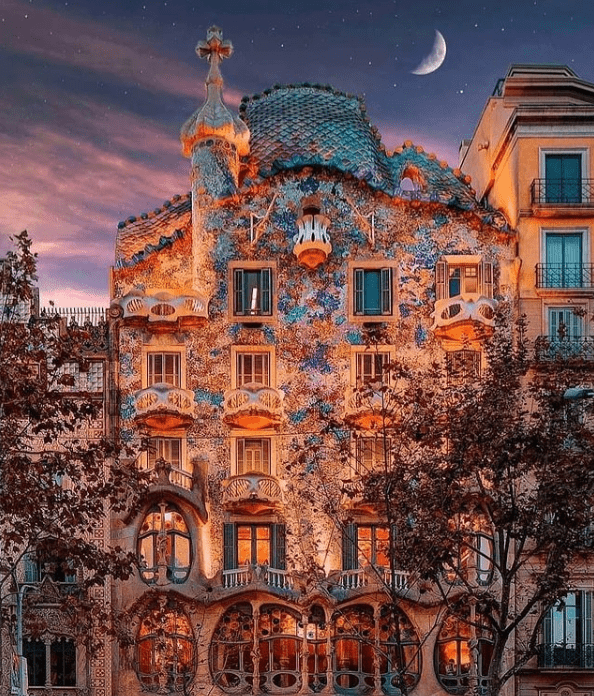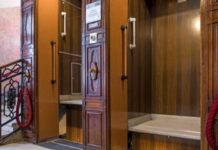Barcelona is the “Catalan capital” and is also the ideal destination for those who love architecture. Here there are precious buildings to visit at least once in a life. Then it is no coincidence that the famous, and extravagant, Catalan architect Antoni Gaudì gave the best of himself in this city.
Among his buildings of great and surreal beauty, one stands out: Casa Batllò, one of Gaudì’s most ingenious constructions and one of Spain’s must-sees.
It was declared a UNESCO World Heritage Site in 2005 and attracts many visitors every year. Is it the most beautiful house in the world?
Is this the MOST BEAUTIFUL HOUSE in the world?
# The rich Spanish families commissioned the creation of unforgettable buildings and Casa Batllò is an example
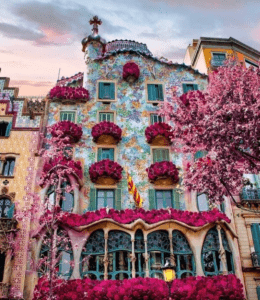
During the industrial revolution, Barcelona changed radically. Entrepreneurs continued to grow rich and compete with each other, commissioning the greatest architects to create buildings that would leave an indelible mark on the city.
It was in this context (1903) that the wealthy Batllò family bought an old building in the Eixample district and turned to Gaudì for its renovation.
The architect was already famous for his other projects and used this commission as an exercise in style. In fact, he modernized the building, replacing the original facade with a set of stones and crystals. Moreover, both the exterior and interior of the house are a triumph of mosaics and stained glass, of soft and undulating lines. In general, these are the hallmarks of the architect’s projects, which always recall the structures and sinuous forms of nature.
# It is an almost neo-gothic aesthetic, but with numerous floral references typical of modernist artists
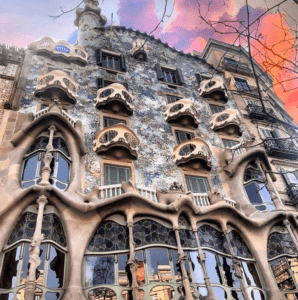
Gaudi had the exterior walls re-carved to give them the famous wavy shape that is common to all his works, and had them plastered with lime. Then he had them covered with the typical Catalan mosaic, the trencadís, which consists of colored glass tiles and ceramic discs.
The undulating roof is also very particular: colored ceramics decorate it and create a chromatic scale. Then you can’t miss the terrace equipped with 4 groups of sinuous chimneys that soar against the sky.
The façade, on the other hand, has tapered columns made of Montjuïc stone that frame particular decorative motifs that recall bone shapes and zoomorphic subjects. An aesthetic that is almost reminiscent of neo-Gothic, but with floral elements typical of modernists.
# The interiors are rich in refined and precious details
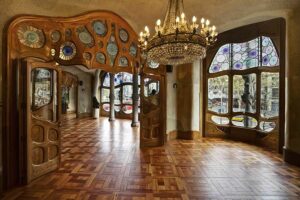
The interior of the house also reflects this originality. In fact, everything was designed by Gaudì, who then commissioned the work to the best craftsmen in Barcelona.
For this unique large building were used: forged iron to make the balconies, magnificent three-dimensional wooden doors, precious leaded crystal that lets natural light filter through and hand-decorated ceramics.
In addition, among the rooms is the so-called “Salone Nobile” which is a true showcase of the house with its colorful stained glass windows overlooking Passeig de Gracia.
# A building rich in stories and legends related to the city
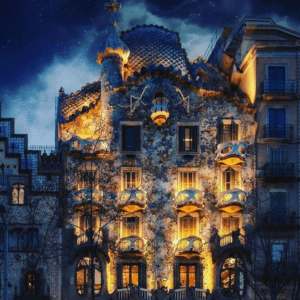
Casa Batllò is a very popular building and is the protagonist of stories and legends related to the city of Barcelona.
For example, it is also called the “house of bones”. To find out why just look at the facade: the balconies look like fragments of skull with openings for eyes and nose and the columns of the second floor look like human bones … These are details that make you think of a human skeleton.
In addition, Casa Batllò is linked to St. George who is the patron saint of Catalonia that killed with his sword the dragon that terrorized the city. TThe figure of this dragon is present in the undulating shapes of the roof that would represent its scaly back. Then, the huge four-armed cross on the roof is the symbol of the triumphant sword of St. George.
Source: www.paesionline.it
ALESSIA LONATI


